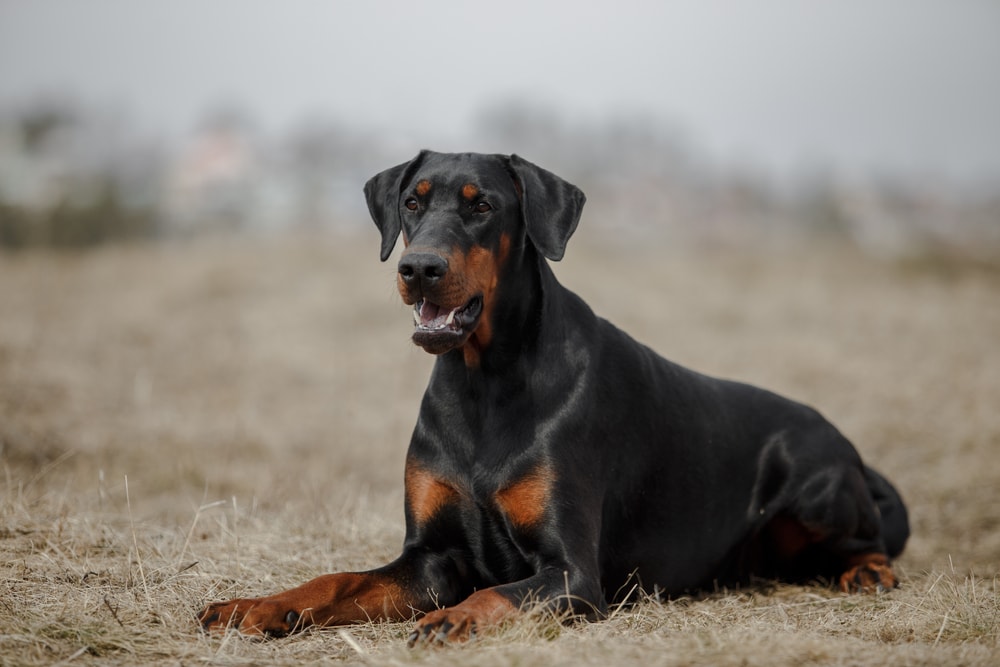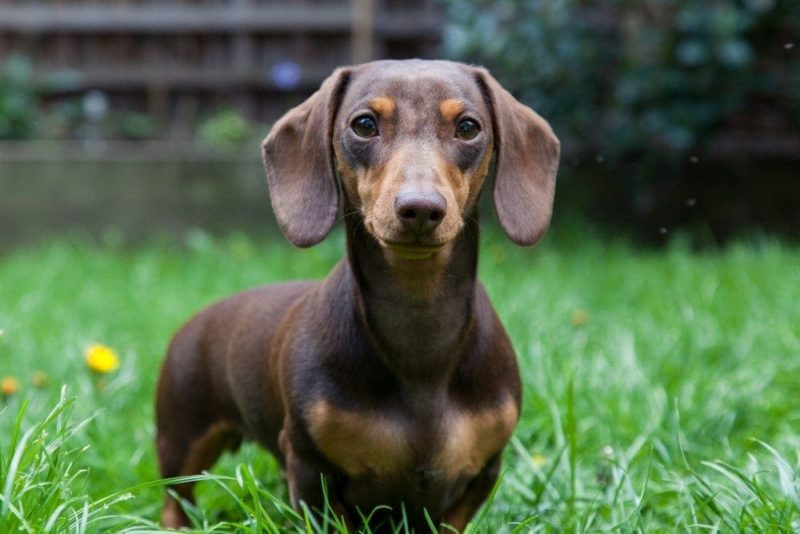How to Potty Train a Basset Hound: 8 Expert Tips

Updated on
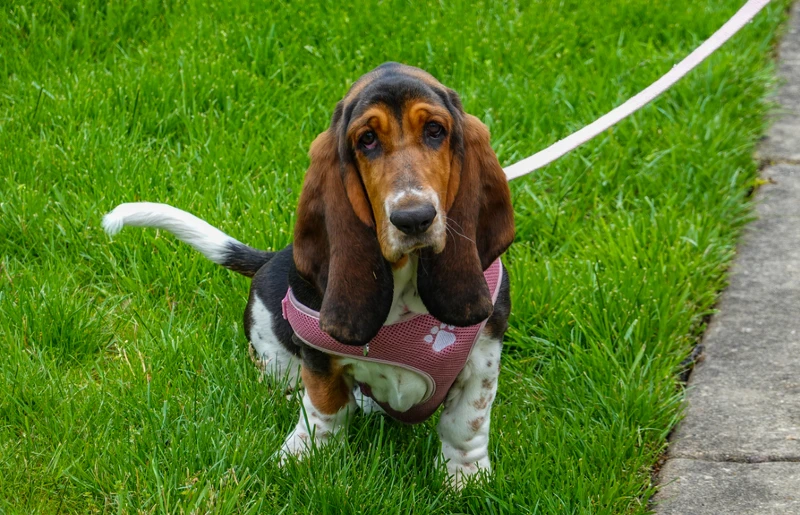
Basset Hounds have a super sensitive nose that can get in the way of successful potty training. With over 220 million smell receptors, these canines are top on the list of dogs with the best sense of smell. Their scent drive gives them a stubborn streak, and potty training can test your patience. It can take anywhere between three weeks and six months before you stop scooping poop from your living spaces.
If you want to potty train a Basset Hound successfully, it is crucial to understand the breed’s natural inclinations. Generally, the desire to please you by going to the potty designated area should be greater than any other distraction.
Need to potty train a Basset Hound fast? We’ve got you covered with eight expert tips that work on all dogs of the breed, irrespective of their age or personality.
Let’s begin!
The 8 Tips to Potty Train a Basset Hound
1. Gather Potty Training Supplies
Your time, dedication, and patience are of fundamental importance when house training a Basset Hound. You’ll also need a few supplies and equipment to make your work easier. Depending on your chosen potty training method, you may need all or some of the following items.
- Leash and collar
- Dog crate
- Pet barriers
- Puppy pads and holder
- Plenty of treats (to use as rewards)
- A pooper scooper and poop bags
- Cleaning products (odor-neutralizer cleaners)
After your training supplies are ready, pay attention to the signs your pet displays right before a potty break. Some Basset Hounds start sniffing and circling, while others stop in their tracks before walking away to find a private area. Having a rough idea of your dog’s pattern of actions can be instrumental in creating an effective potty schedule.
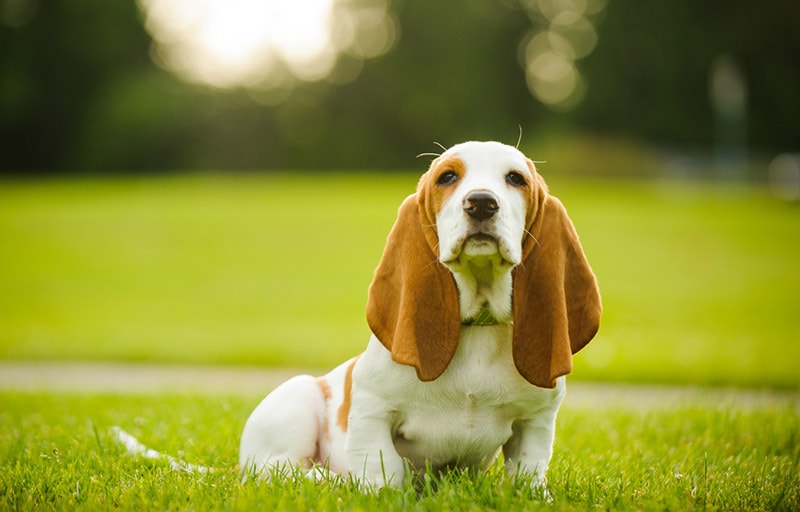
2. Designate a Potty Zone
Basset Hounds don’t like cold weather, and it’s understandable if you must use puppy pads to create an indoor potty zone. However, beware that it can be challenging to condition them to use an outdoor spot once they are used to going indoors.
An easier way to let your dog know it should not relieve itself in the house is to choose an outdoor potty zone. It could even be a spot protected from weather elements. Find out whether your pet’s preferred potty substrate is bare dirt, grass, puppy pads, or concrete, and ensure it’s available in their potty zone.
The idea of having a designated potty area is to ensure your Basset Hound does its business in the same spot each time. This should make cleanups easier and reduce the risk of finding accidents elsewhere. For the best outcome, the potty spot must be free from distractions.
3. Crate Train Your Basset Hound
If you can supervise your pet to know when it wants a potty break, then crate training is not mandatory. However, it can be crucial if you are busy or have not established your pet’s natural potty schedule.
Generally, dogs don’t soil small spaces that are also their designated sleep area. Putting them in a crate for a few hours helps them learn to control their bowels and bladders. If your Basset Hound relieves itself inside the crate, this means there is too much room. Buy a smaller crate or use a divider to reduce the size of the room.
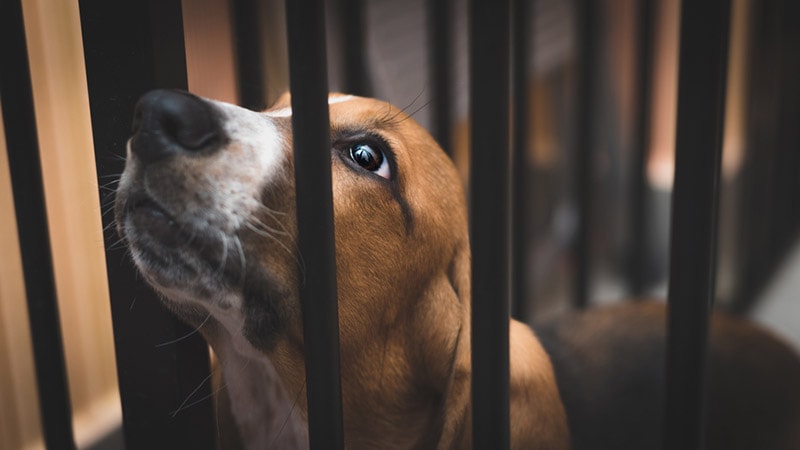
4. Create a Schedule for Visiting the Potty Zone
Adult Basset Hounds can hold their pee for up to eight hours. However, puppies must go after every hour before they turn three months old. They develop better bladder control as they grow older. By the time they turn nine months old, they can keep it together for up to three hours before needing a potty break.
Crate training is essential in ensuring your dog builds the ability to hold its pee for longer. If you take it out too frequently, its bladder strength may not increase as expected. Always be ready to praise and reward your Basset Hound if it holds its bladder and bowel until the scheduled time for visiting the potty zone.
5. Keep Your Basset Hound Focused on the Bathroom Break
Once it is time for a potty break, you must encourage your furry friend to focus on its bathroom business.
Basset Hounds are hunting dogs with a strong attraction to scents and smells. It’s easy for them to forget about the potty break and instead get on a hot trail toward the direction of an interesting smell. Always use a leash to control their movement and direct them to the potty zone. Ensure the leash is long enough to allow some privacy once your pet gets down to business.
If you get to the potty zone and your animal remains distracted or does not potty within five minutes, lead them back into their crate. Wait for at least half an hour before escorting them back to the potty zone again. If they prioritize relieving themselves, you can reward them, then allow them to stroll and sniff around the yard before you return to the house.
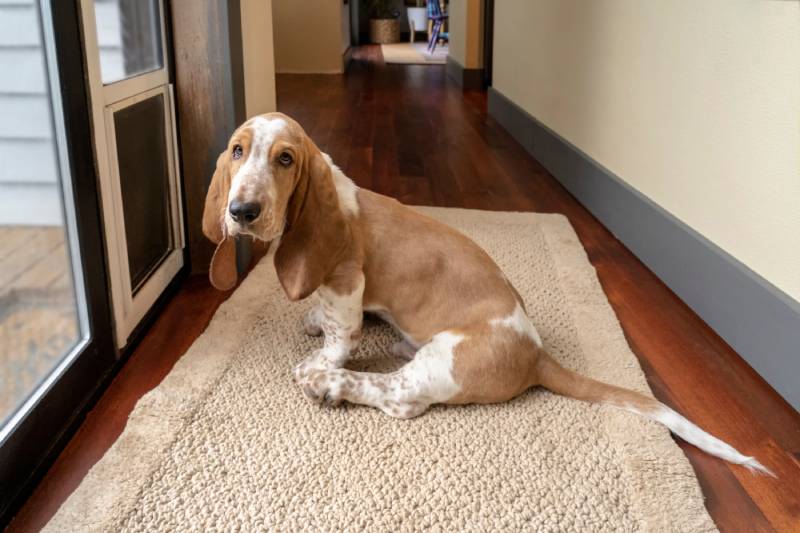
6. Use Verbal Cues to Teach Pottying on Command
Basset Hounds are intelligent and can master different commands with remarkable ease. They are only stubborn because of their natural inclination to follow the source of smells. Encouraging your pet to prioritize the potty break over hot trails can also make teaching it to potty on command easier.
Once you reach the potty zone, use the command “go potty.” With time, your dog will know the relationship between your verbal cue and the expected response. This can help cut down the time spent during potty breaks.
7. Celebrate Successful Potty Breaks
After your furry friend has relieved itself in the correct potty zone, reward it with treats and praise. Ensure you offer the treats immediately to help it develop a positive association with successful potty breaks.
After a warm session of treats, petting, and praises, you can engage it in supervised play. Even better, you can allow your Basset Hound to get on a hot trail and quench its curiosity for an interesting smell.
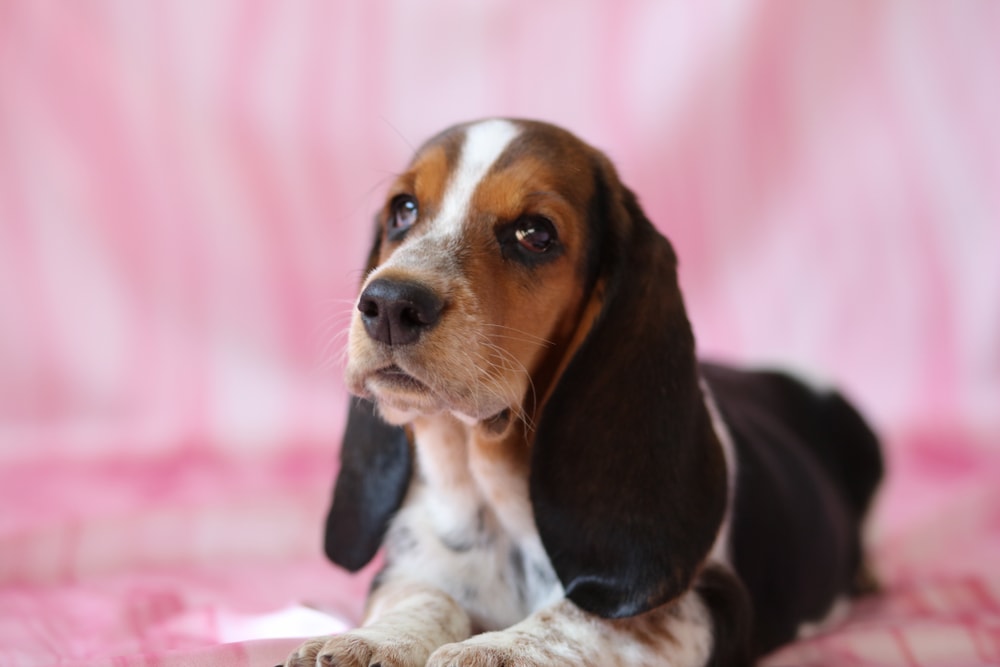
8. Stick to the Set Potty Schedule
Basset Hounds thrive on consistency. It is imperative to set a potty schedule and stick to it. First, depending on your pet’s age, you’ll need to devise an efficient feeding schedule. Puppies should have three meals a day. It would help if you offered the last meal of the day at least four hours before bedtime.
Once you offer a meal, always remove any remaining food from their bowl after half an hour. While providing plenty of water throughout the day is perfectly okay, your pup should have its last sip at least two hours before bedtime.
The first potty run should happen right after your dog wakes up. Also, visit the potty zone after the mid-day meal and before bedtime. Once you have established a housetraining schedule that works beautifully without any accidents, stick to it.
Again, remember to celebrate your wins!
How to Handle Difficult Potty Training Like a Pro
Potty training can be a nightmare, depending on your Basset Hound’s personality. Days of potty break wins don’t guarantee that you are done scooping poop from your living spaces.
If your furry friend goes on a potty strike, it is vital to remain patient and understanding. Punishing or scolding it will only worsen things by making your pet associate potty breaks with a negative experience.
The correct way to handle the situation depends on whether you catch your pet having an accident or after. Here is how to handle a potty strike like a pro.
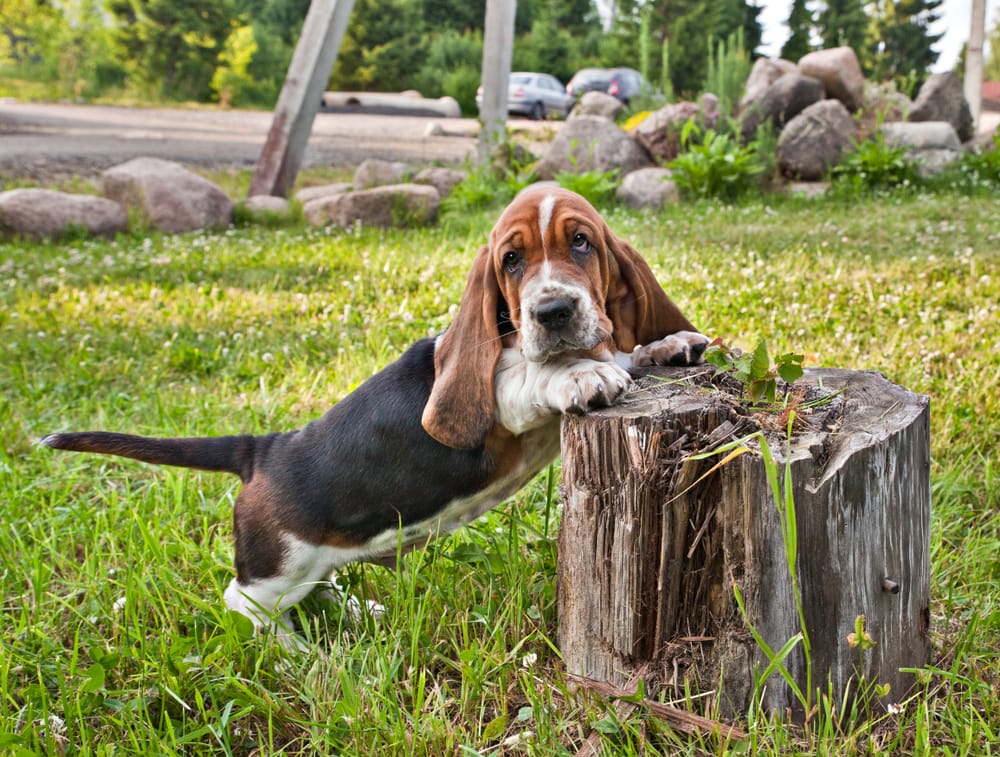
During a Potty Accident
If you catch it in the act, interrupt it by clapping loudly and take it to the potty zone immediately. Once it finishes relieving itself, offer treats and praises.
After a Potty Accident
If you discover your Basset Hound has an accident when it’s too late, this implies it needs more supervision. You must reevaluate your potty training process to determine areas that require adjustment. Maybe you took too long to go for a potty break or missed vital pre-potty signs. In this case, clean the area with a scent-neutralizing cleaner, and don’t offer any treats or praise.
Basset Hounds have an excellent sense of smell. It is imperative to clean the potty mess fast and effectively. Odor-neutralizing products can help eliminate the stink to ensure your pet doesn’t confuse the spot for its new potty zone. If you also find stains on the floor, you’ll have to use an enzyme-based cleaner. Some baking soda and vinegar can also help to sanitize the area and remove odors.
Our favorite enzyme cleaner for eliminating pet smells and stains is our very own Hepper Advanced Bio-Enzyme Pet Stain & Odor Eliminator Spray. It makes clean-up a breeze because it permanently removes even the very worst smells and stains (urine, feces, vomit, you name it!) from basically any surface you can imagine.
- ADVANCED ENZYMATIC CLEANER - Penetrates the most stubborn smells and stains at the deepest molecular...
- FOR ANY MESS, ON ANY SURFACE - This pet odor eliminator cleans your carpets, floors, furniture,...
Final Thoughts
Basset Hounds have plenty of charming qualities that make them excellent furry companions. However, they can be notoriously harder to potty train than most canine breeds. While they are stubborn, you can use their food motivation to your advantage. Chunks of hot dogs or dried liver have a strong smell that can keep them focused on their potty business to ensure they get a reward!
For potty training to succeed, you must approach the process with firmness, consistency, and positive reinforcement. We hope that acting on our expert tips expedites the process of your dog showing excellent toilet habits.
Good luck!
See also:
- Basset Hound Breed Info, Pics, Puppies, Traits & Facts
- Pomapoo (Pomeranian & Toy Poodle Mix): Info, Pictures, Facts
Featured Image Credit: Alan Budman, Shutterstock


